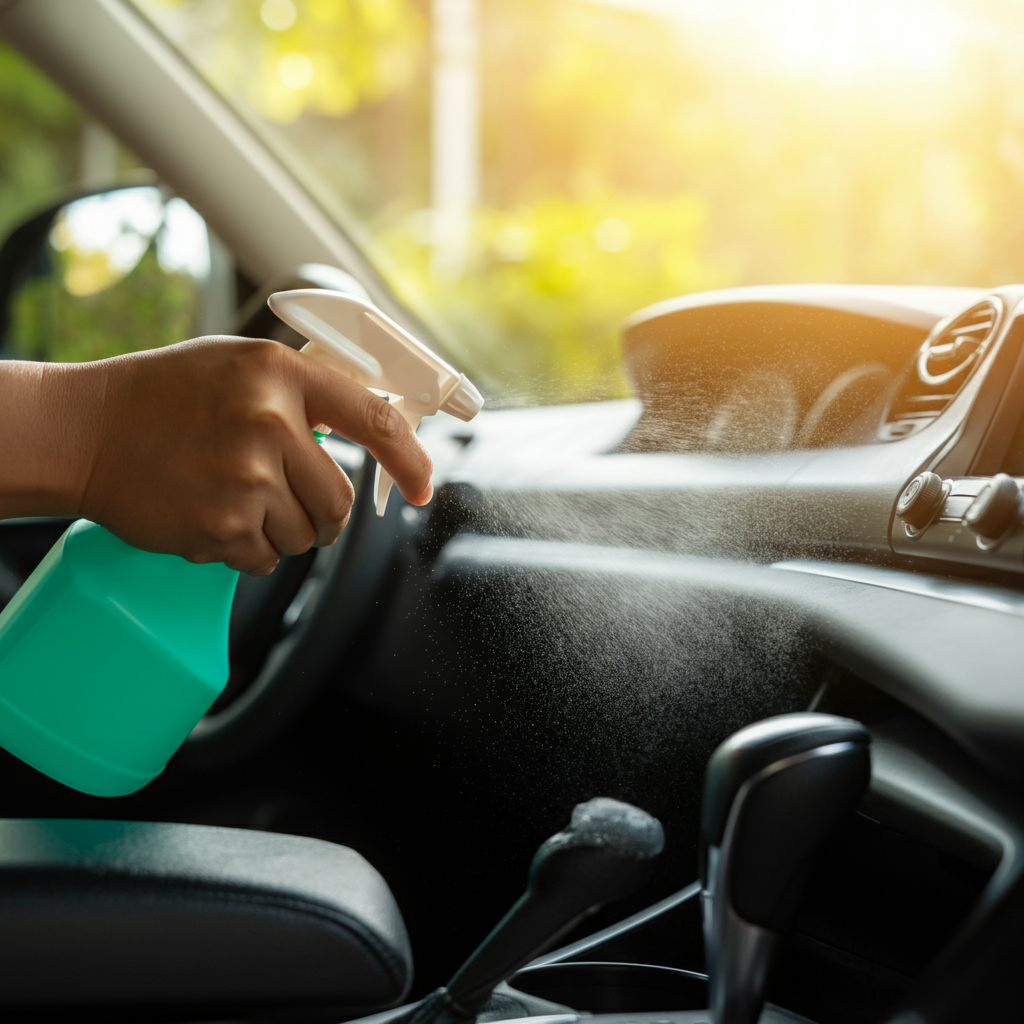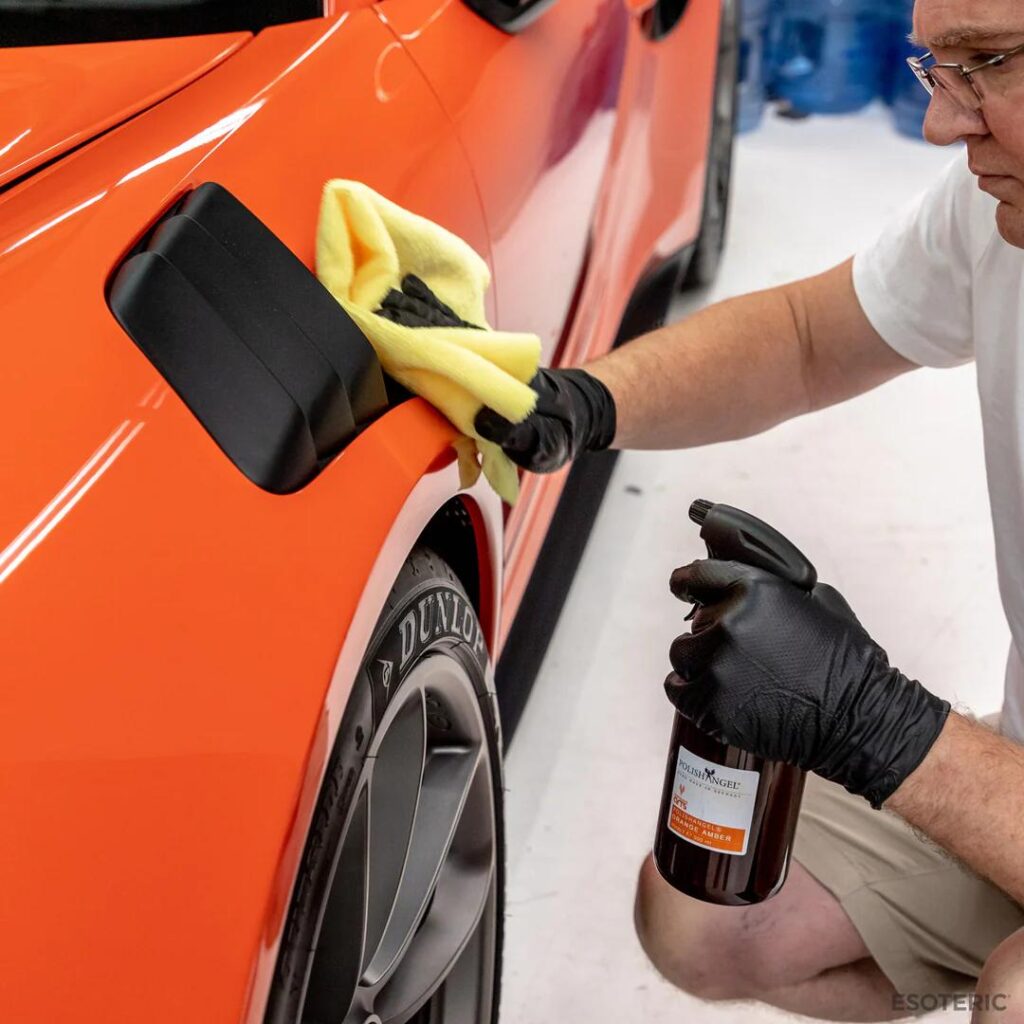As an Amazon Associate, I earn from qualifying purchases
Discovering mold in your car can be both alarming and frustrating. That musty smell that greets you when you open the door, or those dark spots creeping across your upholstery, are clear signs that moisture has taken hold in your vehicle. Car mold isn’t just unsightly—it poses real health risks and can significantly impact your driving experience.
Mold thrives in the enclosed, often humid environment of a vehicle’s interior. Common culprits include water leaks from damaged seals, wet items left inside, or even condensation from temperature changes. Once mold establishes itself, it can spread rapidly through carpets, seat fabric, and air vents, creating an unhealthy environment for you and your passengers.
The good news is that with the right approach and tools, you can effectively eliminate mold from your car and prevent it from returning. This comprehensive guide will walk you through the entire process, from understanding why mold grows in vehicles to implementing long-term prevention strategies. By following these proven methods, you’ll restore your car’s interior to a clean, healthy state while protecting your investment and well-being.
Table of Contents
Why Mold Grows in Cars
Understanding the root causes of mold growth is essential for effective removal and prevention. Cars create the perfect storm of conditions that mold spores need to flourish: moisture, warmth, and organic materials to feed on.

Moisture Sources
The primary driver of mold growth is excess moisture. This can enter your vehicle through various means. Damaged weather stripping around doors and windows allows rainwater to seep in gradually, often going unnoticed until mold appears. Sunroof drains that become clogged can cause water to accumulate in hidden areas. Even seemingly minor issues like a loose door seal can introduce enough moisture over time to create mold-friendly conditions.
Wet clothing, umbrellas, or sports equipment brought into the car can also contribute to elevated humidity levels. During colder months, snow and slush tracked in on shoes and clothing can saturate carpets and floor mats, providing the perfect breeding ground for mold spores.
Poor Ventilation
Modern cars are designed to be airtight for climate control efficiency, but this can work against you when moisture gets trapped inside. Without adequate air circulation, humid conditions persist longer, giving mold spores time to establish colonies. Cars parked in garages or covered areas may experience even less air movement, compounding the problem.
Organic Materials
Car interiors are filled with materials that mold can feed on. Fabric upholstery, carpet padding, leather conditioners, and even dust particles provide nutrients for mold growth. These organic materials, combined with moisture and moderate temperatures, create an ideal environment for various types of mold to thrive.
Climate Factors
Geographic location plays a significant role in mold susceptibility. Vehicles in humid climates face constant challenges from atmospheric moisture, while those in areas with significant temperature fluctuations may experience more condensation issues. Seasonal changes can also create conditions where warm, moist air meets cooler surfaces, leading to condensation that feeds mold growth.
How to Get Mold Out of Your Car (Step-by-Step)
Removing mold from your car requires a systematic approach to ensure complete elimination. Follow these detailed steps for the most effective results.
Step 1: Prepare Your Workspace
Begin by moving your car to a well-ventilated area, preferably outdoors or in an open garage. Open all doors and windows to maximize airflow throughout the cleaning process. Remove all personal items, floor mats, and seat covers that can be taken out for separate cleaning or disposal.
Put on protective gear including rubber gloves, a face mask, and old clothing that you can wash or discard afterward. Mold spores can become airborne during cleaning, so personal protection is crucial.
Take photographs of the affected areas for reference, especially if you plan to document the damage for insurance purposes or warranty claims.
Step 2: Vacuum Thoroughly
Use a vacuum cleaner with a HEPA filter to remove loose mold spores and debris from all surfaces. Pay special attention to crevices, seat joints, and areas where the carpet meets the interior panels. Use appropriate attachments to reach tight spaces around pedals, under seats, and in air vents.
After vacuuming, dispose of the vacuum bag immediately or empty the canister outside your home to prevent spreading spores. Clean the vacuum attachments with a disinfectant solution before storing.
Step 3: Apply Cleaning Solutions
For hard surfaces like dashboard, door panels, and vinyl seats, create a solution using white vinegar and water in equal parts. Spray the affected areas generously and let the solution sit for 10-15 minutes before wiping with a clean microfiber cloth.
For fabric upholstery and carpets, you have several effective options. A baking soda paste made with water can be applied to moldy areas and left to sit for several hours before scrubbing with a soft brush and vacuuming up the residue. Alternatively, commercial enzyme cleaners designed for automotive use can break down mold at the cellular level.
Step 4: Deep Clean Fabrics and Leather
Fabric seats and carpets require more intensive treatment. Use an upholstery cleaner specifically formulated for automotive use, working in small sections to ensure thorough penetration. A steam cleaner can be particularly effective for deep-seated mold in carpet fibers, but ensure complete drying afterward.
For leather seats, use a leather-specific mold cleaner followed by a quality conditioner once the area is completely dry. Avoid using harsh chemicals that can damage or discolor the leather.
Step 5: Address Air Vents and HVAC System
Mold in your car’s ventilation system requires special attention. Replace the cabin air filter, as it likely harbors mold spores. Use a foam-based air conditioning cleaner that can reach into the ductwork to eliminate mold throughout the system.
Run the air conditioning on high with the treatment product as directed, ensuring the cleaning agent circulates through all vents and components.
Step 6: Complete Drying Process
Proper drying is crucial to prevent mold from returning. Use fans to circulate air throughout the vehicle for at least 24-48 hours. In humid conditions, consider using a dehumidifier near the open vehicle.
Check that all cleaned areas are completely dry before closing the vehicle. Moisture remaining in hidden areas can quickly lead to new mold growth.
Step 7: Deodorize and Neutralize Odors
Even after successful mold removal, lingering odors may persist. Activated charcoal bags placed strategically around the interior can absorb remaining odors naturally. Baking soda sprinkled on carpets overnight and vacuumed the next day can also help neutralize musty smells.
Commercial odor eliminators designed for automotive use can provide additional freshening power, but choose products that eliminate odors rather than simply masking them.
Best Cleaning Products for Mold Removal
Selecting the right cleaning products can make the difference between success and frustration in your mold removal efforts.
Natural Solutions
White vinegar stands out as one of the most effective natural mold killers. Its acetic acid content can kill up to 82% of mold species. Create a 50/50 solution with water for general cleaning, or use undiluted vinegar for stubborn areas.
Baking soda offers both cleaning and deodorizing properties. Its alkaline nature makes it inhospitable to mold growth while absorbing odors naturally. Create a paste for scrubbing action or sprinkle directly on affected areas.
Tea tree oil, while more expensive, provides powerful antifungal properties. Mix one teaspoon with one cup of water for an effective spray solution that also leaves a fresh scent.
Commercial Cleaners
Enzyme-based cleaners break down mold at the molecular level, making them highly effective for organic materials like fabric and carpet. Look for products specifically labeled for automotive use.
Quaternary ammonium compounds (found in many commercial mold removers) provide excellent killing power and residual protection against future growth.
Hydrogen peroxide-based cleaners offer strong oxidizing action against mold while being safer than chlorine bleach for enclosed spaces.
Specialized Automotive Products
Foaming upholstery cleaners designed for cars can penetrate deep into seat cushions and carpet padding where household cleaners might not reach effectively.
HVAC system cleaners come in aerosol forms that can navigate through ductwork to address mold in ventilation systems.
Leather-specific mold treatment products clean without damaging or discoloring expensive leather interiors.
How to Prevent Mold in Your Car
Prevention remains the most effective strategy for dealing with car mold. Implementing these proactive measures will save you time, money, and health concerns down the road.
Moisture Control
Keep your car’s interior as dry as possible by addressing leaks promptly. Inspect weather stripping around doors and windows regularly, replacing damaged seals before they allow water infiltration.
Use moisture absorbers like silica gel packets or dedicated car dehumidifiers, especially if you live in a humid climate or park in areas with poor ventilation.
Remove wet items immediately rather than leaving them in the car to dry. This includes gym clothes, umbrellas, and towels that can release moisture into the enclosed space over time.
Regular Maintenance
Establish a routine cleaning schedule that includes vacuuming and wiping down surfaces weekly. Regular cleaning removes the organic debris that mold feeds on while allowing you to spot moisture issues early.
Change your cabin air filter according to manufacturer recommendations or more frequently if you notice musty odors when using the air conditioning or heating system.
Ventilation Strategies
Use your car’s ventilation system regularly to promote air circulation. Even brief periods of running the fan can help prevent stagnant air conditions that favor mold growth.
When possible, park in areas that receive some airflow rather than completely enclosed spaces. If garage parking is necessary, consider using a small fan to maintain air circulation around the vehicle.
Crack windows slightly during mild weather to allow natural ventilation, but ensure security isn’t compromised.
Seasonal Considerations
During humid summer months, use air conditioning regularly to reduce interior humidity levels. The system’s dehumidifying effect helps maintain conditions that are inhospitable to mold growth.
Winter presents unique challenges with wet shoes and clothing. Use all-weather floor mats that can be easily removed and dried, and consider keeping spare towels in the car for immediate cleanup of wet items.
Taking Action Against Car Mold
Successfully removing mold from your car requires patience, the right products, and thorough execution. The health benefits of breathing clean air during your daily commute, combined with protecting your vehicle’s value and your family’s well-being, make this effort worthwhile.
Remember that severe mold infestations may require professional intervention, especially if the contamination has spread throughout the HVAC system or deep into seat cushions. Don’t hesitate to consult automotive detailing professionals or mold remediation specialists when the problem exceeds your comfort level or available time.
The key to long-term success lies in maintaining the dry, clean environment you’ve created. Regular inspections for moisture sources, prompt attention to leaks, and consistent cleaning habits will keep mold from returning to threaten your car’s interior and your health.
Frequently Asked Questions
How do I know if I have mold in my car?
Several clear indicators point to mold growth in your vehicle. The most obvious sign is a persistent musty, earthy odor that doesn’t disappear with regular cleaning or air fresheners. Visually, look for dark spots or discoloration on upholstery, carpets, or interior panels—these often appear as black, green, or brown patches.
Other signs include increased allergy symptoms when driving, such as sneezing, coughing, or respiratory irritation that subsides when you leave the vehicle. Damp or wet areas that don’t seem to dry completely also indicate conditions favorable for mold growth.
Is vinegar effective for removing mold in cars?
Yes, white vinegar is highly effective for mold removal in automotive applications. The acetic acid in vinegar can kill approximately 82% of mold species, making it a powerful natural alternative to chemical cleaners. Its effectiveness comes from lowering the pH level in treated areas, creating an environment where mold cannot survive.
Use a 50/50 solution of white vinegar and water for most applications, or apply undiluted vinegar for stubborn mold patches. Allow the solution to sit for 10-15 minutes before wiping clean. While the vinegar smell may be strong initially, it dissipates quickly and takes the musty mold odor with it.
Can mold in a car be harmful to my health?
Car mold can indeed pose significant health risks, particularly for individuals with allergies, asthma, or compromised immune systems. Common symptoms include respiratory irritation, persistent coughing, sneezing, and sore throat. Some people experience headaches, fatigue, or skin irritation after exposure to mold spores.
The enclosed environment of a car can concentrate mold spores, potentially making exposure more intense than in larger spaces. Children and elderly passengers may be particularly susceptible to mold-related health issues. If you experience unexplained symptoms that seem connected to time spent in your vehicle, mold contamination should be investigated promptly.
How long does it take to remove mold from a car?
The timeline for complete mold removal varies significantly based on the extent of contamination and chosen treatment methods. Minor mold spots on hard surfaces might be eliminated in 2-4 hours, including cleaning and drying time.
More extensive mold problems affecting upholstery, carpets, and HVAC systems typically require 1-3 days for thorough treatment. This includes initial cleaning, drying time (which can take 24-48 hours in humid conditions), and follow-up treatments if necessary.
Severe infestations might need professional intervention and could take a week or more to fully resolve, especially if components need replacement or specialized equipment is required.
Can I use bleach to remove mold from my car?
While bleach is effective at killing mold, it’s not recommended for automotive interiors due to several significant drawbacks. Bleach can permanently discolor or damage upholstery, carpet, and plastic components. The chemical is also harsh in enclosed spaces, potentially creating harmful fumes that linger in the confined environment of a vehicle.
Additionally, bleach only kills surface mold and doesn’t penetrate porous materials effectively, meaning root systems in fabric or carpet padding may survive to regrow later. Instead, opt for automotive-specific mold cleaners, enzyme-based solutions, or natural alternatives like vinegar that are safer and more appropriate for vehicle interiors.
As an Amazon Associate, I earn from qualifying purchases


